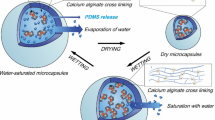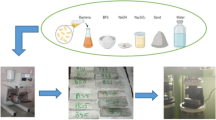Abstract
To protect surfaces against marine biofouling, the continuous leaching of biocides, such as cuprous oxide (Cu2O) and copper pyrithione (CuPT), from antifouling coatings is a widespread and effective method. However, from an environmental and economic perspective (costs of raw materials), a high biocide loading of formulations is not sustainable. Silica aerogel-encapsulated CuPT is a promising approach to reduce Cu2O and CuPT loadings without compromising the mechanical properties and antifouling performance of the coating. In the present study, silica aerogels, with varying CuPT loadings, were incorporated into model coating formulations, and selected coating properties, i.e., rheology, water absorption, and hardness, were measured and evaluated. Furthermore, to demonstrate antifouling performance, static exposure testing with the aerogel-containing coatings was performed. The level of CuPT loading of the silica aerogels did not have a significant influence on neither the water absorption nor the rheology of the coating. However, an increase in the CuPT loading of the aerogel from 0 to 80 wt% reduced the coating’s pendulum hardness from 61 to 37 s. Additionally, compared to a reference coating with nonencapsulated CuPT, results demonstrate that a coating containing silica aerogel-encapsulated CuPT provides a 17% higher antifouling resistance when evaluated according to guidance from The European Chemicals Agency.








Similar content being viewed by others
References
Srinivasan, M, Swain, GW, “Managing the Use of Copper-Based Antifouling Paints.” Environ. Manag., 39 (3) 423–441 (2007)
Bao, VWW, Leung, KMY, Lui, GCS, Lam, MHW, “Acute and Chronic Toxicities of Irgarol Alone and in Combination with Copper to the Marine Copepod Tigriopus japonicus.” Chemosphere, 90 (3) 1140–1148 (2013)
Turner, A, Pollock, H, Brown, MT, “Accumulation of Cu and Zn from Antifouling Paint Particles by the Marine Macroalga, Ulva lactuca.” Environ. Pollut., 157 (8–9) 2314–2319 (2009)
Adeleye, AS, Oranu, EA, Tao, M, Keller, AA, “Release and Detection of Nanosized Copper from a Commercial Antifouling Paint.” Water Res., 102 374–382 (2016)
Bighiu, MA, Gorokhova, E, Almroth, BC, Wiklund, A-KE, “Metal Contamination in Harbours Impacts Life-History Traits and Metallothionein Levels in Snails.” PLoS One, 12 (7) e0180157 (2017)
Katranitsas, A, Castritsi-Catharios, J, Persoone, G, “The Effects of a Copper-Based Antifouling Paint on Mortality and Enzymatic Activity of a Non-target Marine Organism.” Mar. Pollut. Bull., 46 (11) 1491–1494 (2003)
Jones, RJ, “Chemical Contamination of a Coral Reef by the Grounding of a Cruise Ship in Bermuda.” Mar. Pollut. Bull., 54 (7) 905–911 (2007)
Miller, RJ, et al. “Nano and Traditional Copper and Zinc Antifouling Coatings: Metal Release and Impact on Marine Sessile Invertebrate Communities.” J. Nanopart. Res., 22 (5) 1–15 (2020)
Cresson, E, "Council Directive 89/677/EEC of 21 December 1989 Amending for the Eighth Time Directive 76/769/EEC." Offic. J. Eur. Commun. (1989)
Dimas, S, "Commission Decision 2007/565/EC." Offic. J. Eur. Union (2007)
Juncker, J-C, "Commission Implementing Decision (EU) 2016/107." Offic. J. Eur. Union (2016)
European Parliament and Council, "The EU Biocidal Products Regulation (No. 528/2012)." (2012)
Paz-Villarraga, CA, Castro, ÍB, Fillmann, G, “Biocides in Antifouling Paint Formulations Currently Registered for Use.” Environ. Sci. Pollut. Res., 1 1–12 (2022)
Lagerström, M, Ytreberg, E, Wiklund, AKE, Granhag, L, “Antifouling Paints Leach Copper in Excess—Study of Metal Release Rates and Efficacy Along a Salinity Gradient.” Water Res., 186 116383 (2020)
Nowicka, B, “Heavy Metal–Induced Stress in Eukaryotic Algae—Mechanisms of Heavy Metal Toxicity and Tolerance with Particular Emphasis on Oxidative Stress in Exposed Cells and the Role of Antioxidant Response.” Environ. Sci. Pollut. Res., 29 (12) 16860–16911 (2022)
Amara, I, Miled, W, Slama, RB, Ladhari, N, “Antifouling Processes and Toxicity Effects of Antifouling Paints on Marine Environment. A Review.” Environ. Toxicol. Pharmacol., 57 115–130 (2018)
Borkow, G, Gabbay, J, “Copper as a Biocidal Tool.” Curr. Med. Chem., 12 (18) 2163–2175 (2005)
Harwood-Sears, V, Gordon, AS, “Copper-Induced Production of Copper-Binding Supernatant Proteins by the Marine Bacterium Vibrio alginolyticus.” Appl. Environ. Microbiol., 56 (5) 1327 (1990)
Cooksey, DA, “Molecular Mechanisms of Copper Resistance and Accumulation in Bacteria.” FEMS Microbiol. Rev., 14 (4) 381–386 (1994)
Lovelett, L, Rolfes, C, Wilson, C, Senate Bill 6210/ HB 2385 (2020)
Vogel, G, Senate Bill Report SB 6210 (2020)
Auken, I, "Statutory Order Restricting the Import, Sale and Use of Biocidal Antifouling Products." The Danish Environmental Protection Agency (EPA) https://eng.mst.dk/chemicals/biocides/legislation/statutory-order-restricting-the-import-sale-and-use-of-biocidal-anti-fouling/ (2011)
Leahy, BR, Brown, EG, "New Regulations for Copper-Based Antifouling Paint Pesticide Products." (2018)
Frydenberg, T, Weinell, CE, Dam-Johansen, K, Wallström, E, Kiil, S, "Characterization and Release Mechanisms of Aerogel-encapsulated Biocide Crystals for Low-loading and High-utilization Antifouling Coatings." (2022)
Lars, T, Jarle, R, Anders, B, "Granulated Cuprous Oxide for Antifouling Coatings." (2002)
Jarle, R, Technical Data Sheet, Nordox Cuprous Oxide Red Paint Grade. (2017)
Jarle, R, Technical Data Sheet, Nordox Cuprous Oxide XLT-G. (2020)
European Chemical Agency. Guidance on the Biocidal Products Regulation (Volume II Efficacy - Assessment and Evaluation (Parts B + C), Version 3.0). Vol. III (2018)
Pinori, E, Elwing, H, Berglin, M, “The Impact of Coating Hardness on the Anti-Barnacle Efficacy of an Embedded Antifouling Biocide.” Biofouling, 29 (7) 763–773 (2013)
Cassé, F, Swain, GW, “The Development of Microfouling on Four Commercial Antifouling Coatings Under Static and Dynamic Immersion.” Int. Biodeterior. Biodegrad., 57 (3) 179–185 (2006)
Vw, B, Km, L, Jw, Q, Mh, L, “Acute Toxicities of Five Commonly Used Antifouling Booster Biocides to Selected Subtropical and Cosmopolitan Marine Species.” Mar. Pollut. Bull., 62 (5) 1147–1151 (2011)
Yamada, H, "Behaviour Occurrence and Aquatic Toxicity of New Antifouling Biocides and Preliminary Assessment of Risk to Aquatic Ecosystems." Bull. Fish. Res. Agen., 21 31–45 (2007)
Onduka, T, et al. “Toxicity of Metal Pyrithione Photodegradation Products to Marine Organisms with Indirect Evidence for Their Presence in Seawater.” Arch. Environ. Contam. Toxicol., 58 (4) 991–997 (2010)
Kiil, S, Weinell, CE, Pedersen, MS, Dam-Johansen, K, “Analysis of Self-Polishing Antifouling Paints Using Rotary Experiments and Mathematical Modeling.” Ind. Eng. Chemistry Res., 40 (18) 3906–3920 (2001)
Yebra, DM, Kiil, S, Dam-Johansen, K, Weinell, CE, “Mathematical Modeling of tin-Free Chemically-Active Antifouling Paint Behavior.” AIChE J., 52 (5) 1926–1940 (2006)
Risk Assessment Report Zinc Oxide (European Chemicals Agency). The Netherlands (2008)
Neff, JM, "Zinc in the Ocean." Bioaccumul. Mar. Organ. (June) 175–189. https://doi.org/10.1016/b978-008043716-3/50011-7 (2002)
Acknowledgments
The authors would like to acknowledge the Innovation Fund Denmark for financial support (Grant number 8053-00249B) and the Hempel Foundation for funding to CoaST (The Hempel Foundation Coatings Science and Technology Centre).
Author information
Authors and Affiliations
Corresponding author
Additional information
Publisher's Note
Springer Nature remains neutral with regard to jurisdictional claims in published maps and institutional affiliations.
Supplementary Information
Below is the link to the electronic supplementary material.
Rights and permissions
Springer Nature or its licensor holds exclusive rights to this article under a publishing agreement with the author(s) or other rightsholder(s); author self-archiving of the accepted manuscript version of this article is solely governed by the terms of such publishing agreement and applicable law.
About this article
Cite this article
Frydenberg, T., Weinell, C.E., Dam-Johansen, K. et al. Silica aerogel-encapsulated biocide crystals for low-loading antifouling coatings: rheology, water absorption, hardness, and biofouling protection. J Coat Technol Res 20, 935–947 (2023). https://doi.org/10.1007/s11998-022-00713-y
Received:
Revised:
Accepted:
Published:
Issue Date:
DOI: https://doi.org/10.1007/s11998-022-00713-y




